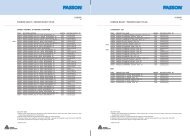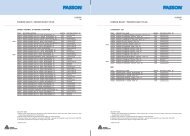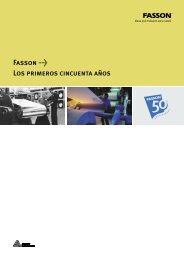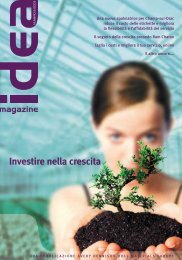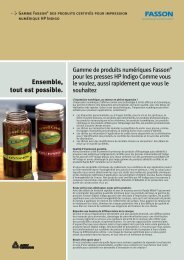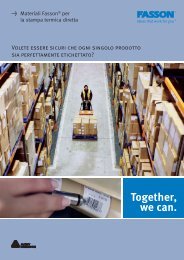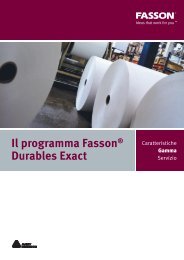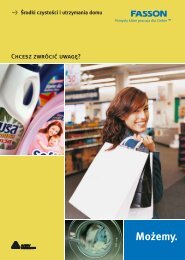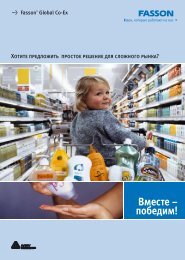open your EYES to MORE labelling SOLUTIONS - Avery Dennison ...
open your EYES to MORE labelling SOLUTIONS - Avery Dennison ...
open your EYES to MORE labelling SOLUTIONS - Avery Dennison ...
Create successful ePaper yourself
Turn your PDF publications into a flip-book with our unique Google optimized e-Paper software.
3. General information about<br />
our products<br />
The Fasson faces<strong>to</strong>cks. Our<br />
faces<strong>to</strong>cks have been developed <strong>to</strong><br />
give optimal conversion and printer<br />
performance. Some products are<br />
multifunctional and can be used in all<br />
print technologies, whilst others are<br />
specifi cally designed for laser copier<br />
or inkjet use. For more information,<br />
please see Chapter 4, ‘Fasson Product<br />
Ranges’.<br />
Where high quality print resolution is<br />
required for pho<strong>to</strong>realistic prints, we<br />
have developed specifi c <strong>to</strong>p coated<br />
papers and polyester fi lms <strong>to</strong> give<br />
short drying time, and <strong>to</strong> ensure that<br />
consumers’ expectations are met, not<br />
only from the print perspective, but<br />
also from the handling point of view.<br />
The range of laser printable polyester<br />
fi lms all utilise heat stabilised polyester<br />
fi lms <strong>to</strong> reduce heat shrinkage and<br />
subsequent post-printer curl. This is<br />
normally negligible when printing die<br />
cut or butt cut labels on A4 sheets.<br />
Our EDP faces<strong>to</strong>cks are made up<br />
generally of uncoated papers that<br />
give a good laser and dot matrix print.<br />
Some papers like the ZigZag and the<br />
Data 75 have been developed <strong>to</strong> give<br />
good pre-printing with conventional<br />
print technologies such as UV Flexo.<br />
These products will also take a basic<br />
Thermal Transfer print.<br />
All our papers are made out of<br />
environmental friendly ECF or TCF pulp.<br />
The Fasson release liners.<br />
Release liners are key in the<br />
performance of self-adhesive<br />
products. Our products are available<br />
with release liners of various types<br />
and basic weights, each designed for<br />
specifi c applications.<br />
For A4 fed products, the quality of the<br />
release liner greatly contributes <strong>to</strong> the<br />
layfl at of the product, and infl uences<br />
its conversion and printing properties.<br />
Generally, the lower weight liners<br />
(45 and 55 grams) offer the correct<br />
fl exibility <strong>to</strong> run on a wide set of A4<br />
printers without problems. Here, long<br />
grain conversion is recommended for<br />
universal end-use.<br />
Where small offi ce printers are used<br />
with an s-curved path, short grain<br />
conversion can be considered for use<br />
from the paper cassette. Using the<br />
manual feeder on a printer is less<br />
critical, and is generally recommended<br />
by the printer manufacturers.<br />
For specifi c industrial uses in A4<br />
fed products, the higher weight<br />
liners such as AT 70 or HF 80 are<br />
recommended. The higher rigidity<br />
offers advantages in cases where the<br />
sheets are perforated, and/or the<br />
facepaper is diecut in<strong>to</strong> many small<br />
labels.<br />
Specifi cally for the use on fi lmic<br />
materials in laser printers, the HF 100<br />
release liner offers optimal layfl at<br />
performance.<br />
For continuous fed EDP products,<br />
layfl at is less critical, but high<br />
strength and stiffness are required<br />
for fanfolding. In general, glassine<br />
liners are used for lower printing<br />
speed applications, whilst 70 or 80<br />
gram kraft liners are used for optimal<br />
stability on high-speed laser printing.<br />
For both A4 and continuous products,<br />
our release levels have been<br />
optimised for high-speed conversion,<br />
ensuring prevention of label lift in<br />
the printers, while enabling ease of<br />
removal by the end user.



